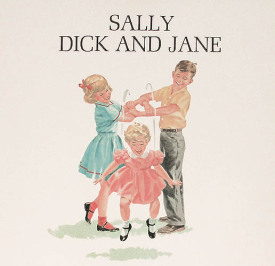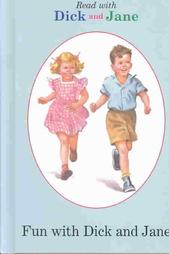Let's Hear It For REAL Books
 Monday, February 2, 2009 at 3:34AM
Monday, February 2, 2009 at 3:34AM From Monday's New York Times
February 1, 2009 The Medium
Click and Jane
“Did you like this book?” asks the computer. It’s a customer-satisfaction question, but it seems more profound than that.
We hesitate. Ben, my 3-year-old son, shoots me a puzzled look. The answer should be yes. Ben enjoys what’s on the screen right now: Starfall, an online medley of free learn-to-read activities. But he doesn’t like the question.
“It’s not a book,” he explains, emphatically, to the laptop. “It’s more like a movie or a video.”
Oh, God. I knew it.
In a hundred ways, we pretend that screen experiences are books — PowerBooks, notebooks, e-books — but even a child knows the difference. Reading books is an operation with paper. Playing games on the Web is something else entirely. I need to admit this to myself, too. I try to believe that reading online is reading-plus, with the text searchable, hyperlinked and accompanied by video, audio, photography and graphics. But maybe it’s just not reading at all. Just as screens aren’t books.
I kind of like that Ben is not remotely fooled by Starfall’s booklike graphics. The site is loaded with all kinds of biblio-iconography: title pages, tables of contents, frontispieces, page numbers and covers. But, to him, nothing that plays on a screen is a book. And though 20th-century critics like Roland Barthes encouraged readers to see textual experience as play, it’s quite possible that nothing that plays is a book.
In their book “Freakonomics,” Stephen J. Dubner and Steven D. Levitt write that kids who grow up in houses packed with books fare better on school tests than those who grow up with fewer books. But they also contend that reading aloud to children and limiting their TV time has no correlation with success on tests. If both of these observations hold, it’s worth determining what books really are, the better to decisively decorate with them. The widespread digitization of text has complicated the matter. Will Ben benefit if I load my Kindle with hundreds of books that he can’t see? Or does he need the spectacle of hard- and softcover dust magnets eliminating floor space in our small apartment to get the full “Freakonomics” effect? I sadly suspect he needs the shelves and dust.
Anyway, Ben doesn’t distinguish between my Kindle and a BlackBerry. My immersion in the Kindle is not (to him) an example of impressive role-model literacy. It’s Mom e-mailing, or texting, or for all he knows playing video games. In fact, the only time he describes what he and I do together as “reading” is when we’re sitting with a clutch of pages bound between covers, open in front of us like a hymnal.
Starfall, a lovably cluttered site, includes games (match “d” with a picture of a drum) with its offerings, and perhaps the proximity of these games to the site’s “books” (artless plot summaries called “The Wooden Horse” or “The Little Red Hen”) is what leads to a category error. But there’s also the pesky fact that the pictures in Starfall’s would-be picture books tend to fidget. They’re animated. Something about an audience of kids apparently makes it hard for authors to refrain from animating: if an image for children can be made to dance around, it usually does.
One More Story, a subscription-only online children’s library that first appeared in 2005, takes exception to this treatment of images. The site, which maintains a sublicensing arrangement with 13 publishers, offers only picture books that have already been published. It does not use cartoons of any kind. You can find “The Snowy Day” on One More Story, as well as “The Poky Little Puppy” and “Stellaluna.” “The books are never animated,” Carl Teitelbaum, a onetime “Sesame Street” contributor who created the site, explained to me by e-mail message. “We do not alter the text or the illustrations at all.”
But One More Story also demonstrates that — as Barthes and his fellow critics might have put it — every translation entails a reworking. It’s impossible to render books as pixels without making changes. “We do take the text out of the page and place it in a text box in a size type that children can easily follow,” Teitelbaum conceded. Moreover, voice-over is added, so a child can have a book read to him.
One More Story does not use facsimiles of the lettering in a book, even if a book is hand-lettered or idiosyncratically lettered. Nonetheless, Teitelbaum explained: “We try to match the typeface with the typeface in the book so going to the actual books will be a smooth transition. We sometimes go in for close-ups, the way your eye might, when the text refers to a portion of the illustration.” Hmm. All this reconceptualization, and scoring and even sound effects: sounds like filmmaking to me.
And yet. While some movie devices show up on One More Story, great pains are taken to preserve — even enhance — the booklike feel of the works in the online library. The gutter of the book is shown, the pages are slightly curved and shadows are used to create an impression of depth. It’s kind of funny to go to the trouble to radically reconceive a book for new distribution and display, only to have to add back some of its humblest physical qualities. “This realistic portrayal is very intentional,” Teitelbaum explained. “When a child has a positive experience, we want that child to know that they have just read a book, not seen a cartoon or video game.”
I’d like that, too. I’d like for Ben to sit with One More Story and come away with the impression that he’d been read beautiful books all afternoon. But Ben tends to ask for One More Story when he wants privacy, the same state of mind in which he likes videos. Books, by contrast, are for when he feels snuggly.
Which brings up something significant about books for a 3-year-old: whatever else preschool reading is, it’s intimate. Before you can read, you get to see books mostly when you’re cuddled up with an adult or jostling with other kids in a circle. In one significant sense, then, One More Story may be closer to true reading than even the ink-on-paper books (with real gutters!) that I read aloud: Ben can do it himself. As he maneuvers the computer trackpad and he shoos me away so he can study (for the 10th time) “Sidney Won’t Swim” on One More Story, I’m not sure he’s developing an appreciation for books. But he is learning how to enrich his solitude, and that is one of the most intensely pleasurable aspects of literacy.
 Dana
Dana
For my non-American friends who probably didn't get the title parody of "Click and Jane" in the NY Times article...

Dick and Jane
From Wikipedia, the free encyclopedia
Jump to: navigation, search
| This article does not cite any references or sources. Please help improve this article by adding citations to reliable sources. Unverifiable material may be challenged and removed. (September 2008) |
Dick and Jane were the main characters in popular basal readers written by Dr. William S. Gray and published by Scott Foresman, that were used to teach children to read from the 1930s through to the 1970s in the United States. There is controversy as to plagiarism of another work however, with Dr. Gray accused of copying Sir Fred Schonell's similar Dick and Dora readers found in his Happy Venture Playbooks. It is known that the original premise of Gray's readers were in fact appropriated from his Australian contemporary Schonell. The main characters, Dick and Jane, were a little boy and girl. Supporting characters included Baby (or Sally), Mother, Father, Spot the dog, Puff the cat, Jack the clown and Tim the teddy bear. They first appeared in the Elson-Gray Readers used in the 1930s. The books relied on sight reading (or "whole word reading") and repetition, using phrases like, "Oh, see. Oh, see Jane. Funny, funny Jane," and they ignored phonics. For this reason, they came to be used less and less as studies supported phonics as a more effective method of gaining literacy.[citation needed]
The simple but distinctive illustrations for the books were done by artists Eleanor Campbell and Keith Ward. Robert Childress did the illustrations during the 1950s.
Black characters and characters from other races and cultures were not introduced until 1965, when Dick and Jane books were already declining in popularity. In 1955 Rudolf Flesch criticized the Dick and Jane series in his book, Why Johnny Can't Read, and the push for multiculturalism, and stronger presentation of other races and cultures was partially a reaction to the cultural homogeneity of the series.
First editions of the books are now worth as much as two hundred dollars. The books were reissued in 2003 by Grosset & Dunlap, an imprint of Penguin Group (USA) and over 2.5 million copies were sold, but this time the publishers had warned against using them to teach reading to children. Related merchandise, such as shirts and magnets, also gained wide popularity, particularly among people who had never been exposed to the original series but were familiar with catch phrases like "See Spot run!"
The title of one of the books, Fun with Dick and Jane, inspired a 1977 film of the same title, and its 2005 remake.
 Dana |
Dana |  Post a Comment |
Post a Comment |  Dick and Jane,
Dick and Jane,  Technology,
Technology,  literacy in
literacy in  Americana,
Americana,  Newspaper Article - NY Times,
Newspaper Article - NY Times,  literacy
literacy 